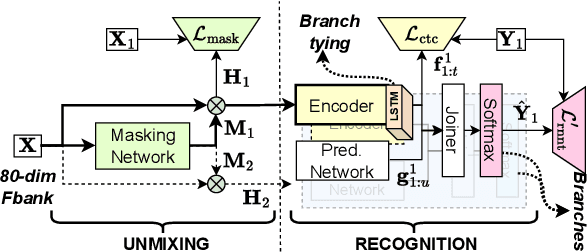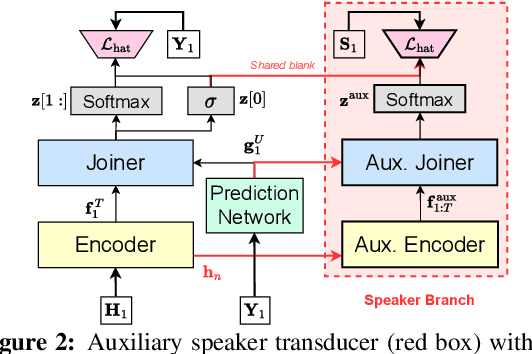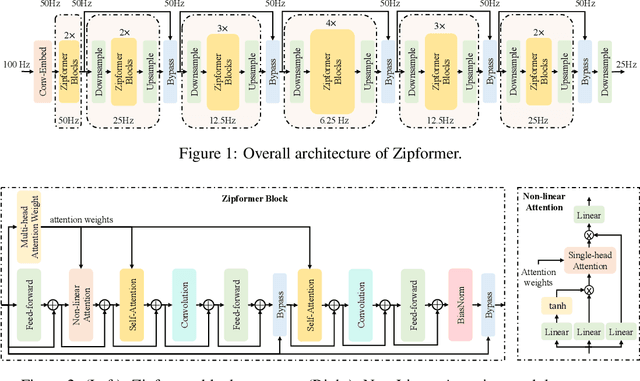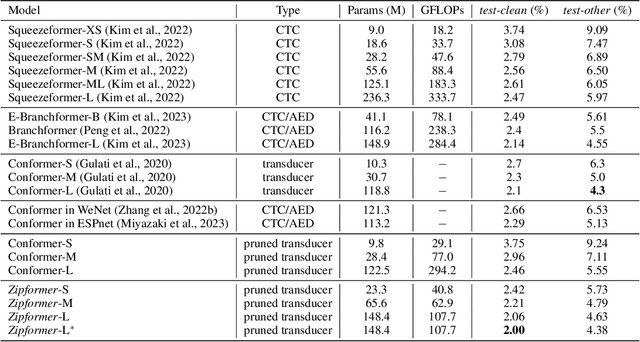Daniel Povey
ZipVoice: Fast and High-Quality Zero-Shot Text-to-Speech with Flow Matching
Jun 16, 2025Abstract:Existing large-scale zero-shot text-to-speech (TTS) models deliver high speech quality but suffer from slow inference speeds due to massive parameters. To address this issue, this paper introduces ZipVoice, a high-quality flow-matching-based zero-shot TTS model with a compact model size and fast inference speed. Key designs include: 1) a Zipformer-based flow-matching decoder to maintain adequate modeling capabilities under constrained size; 2) Average upsampling-based initial speech-text alignment and Zipformer-based text encoder to improve speech intelligibility; 3) A flow distillation method to reduce sampling steps and eliminate the inference overhead associated with classifier-free guidance. Experiments on 100k hours multilingual datasets show that ZipVoice matches state-of-the-art models in speech quality, while being 3 times smaller and up to 30 times faster than a DiT-based flow-matching baseline. Codes, model checkpoints and demo samples are publicly available.
k2SSL: A Faster and Better Framework for Self-Supervised Speech Representation Learning
Nov 26, 2024Abstract:Self-supervised learning (SSL) has achieved great success in speech-related tasks, driven by advancements in speech encoder architectures and the expansion of datasets. While Transformer and Conformer architectures have dominated SSL backbones, encoders like Zipformer, which excel in automatic speech recognition (ASR), remain unexplored in SSL. Concurrently, inefficiencies in data processing within existing SSL training frameworks, such as fairseq, pose challenges in managing the growing volumes of training data. To address these issues, we propose k2SSL, an open-source framework that offers faster, more memory-efficient, and better-performing self-supervised speech representation learning, with a focus on downstream ASR tasks. The optimized HuBERT and proposed Zipformer-based SSL systems exhibit substantial reductions in both training time and memory usage during SSL training. Experiments on LibriSpeech and Libri-Light demonstrate that Zipformer-based SSL systems significantly outperform comparable HuBERT and WavLM systems, achieving a relative WER reduction on dev-other/test-other of up to 34.8%/32.4% compared to HuBERT Base after supervised fine-tuning, along with a 3.5x pre-training speedup in total GPU hours.
CR-CTC: Consistency regularization on CTC for improved speech recognition
Oct 07, 2024



Abstract:Connectionist Temporal Classification (CTC) is a widely used method for automatic speech recognition (ASR), renowned for its simplicity and computational efficiency. However, it often falls short in recognition performance compared to transducer or systems combining CTC and attention-based encoder-decoder (CTC/AED). In this work, we propose the Consistency-Regularized CTC (CR-CTC), which enforces consistency between two CTC distributions obtained from different augmented views of the input speech mel-spectrogram. We provide in-depth insights into its essential behaviors from three perspectives: 1) it conducts self-distillation between random pairs of sub-models that process different augmented views; 2) it learns contextual representation through masked prediction for positions within time-masked regions, especially when we increase the amount of time masking; 3) it suppresses the extremely peaky CTC distributions, thereby reducing overfitting and improving the generalization ability. Extensive experiments on LibriSpeech, Aishell-1, and GigaSpeech datasets demonstrate the effectiveness of our CR-CTC, which achieves performance comparable to, or even slightly better than, that of transducer and CTC/AED.
LibriheavyMix: A 20,000-Hour Dataset for Single-Channel Reverberant Multi-Talker Speech Separation, ASR and Speaker Diarization
Sep 01, 2024



Abstract:The evolving speech processing landscape is increasingly focused on complex scenarios like meetings or cocktail parties with multiple simultaneous speakers and far-field conditions. Existing methodologies for addressing these challenges fall into two categories: multi-channel and single-channel solutions. Single-channel approaches, notable for their generality and convenience, do not require specific information about microphone arrays. This paper presents a large-scale far-field overlapping speech dataset, crafted to advance research in speech separation, recognition, and speaker diarization. This dataset is a critical resource for decoding ``Who said What and When'' in multi-talker, reverberant environments, a daunting challenge in the field. Additionally, we introduce a pipeline system encompassing speech separation, recognition, and diarization as a foundational benchmark. Evaluations on the WHAMR! dataset validate the broad applicability of the proposed data.
Improving Neural Biasing for Contextual Speech Recognition by Early Context Injection and Text Perturbation
Jul 14, 2024Abstract:Existing research suggests that automatic speech recognition (ASR) models can benefit from additional contexts (e.g., contact lists, user specified vocabulary). Rare words and named entities can be better recognized with contexts. In this work, we propose two simple yet effective techniques to improve context-aware ASR models. First, we inject contexts into the encoders at an early stage instead of merely at their last layers. Second, to enforce the model to leverage the contexts during training, we perturb the reference transcription with alternative spellings so that the model learns to rely on the contexts to make correct predictions. On LibriSpeech, our techniques together reduce the rare word error rate by 60% and 25% relatively compared to no biasing and shallow fusion, making the new state-of-the-art performance. On SPGISpeech and a real-world dataset ConEC, our techniques also yield good improvements over the baselines.
Multi-Channel Multi-Speaker ASR Using Target Speaker's Solo Segment
Jun 17, 2024Abstract:In the field of multi-channel, multi-speaker Automatic Speech Recognition (ASR), the task of discerning and accurately transcribing a target speaker's speech within background noise remains a formidable challenge. Traditional approaches often rely on microphone array configurations and the information of the target speaker's location or voiceprint. This study introduces the Solo Spatial Feature (Solo-SF), an innovative method that utilizes a target speaker's isolated speech segment to enhance ASR performance, thereby circumventing the need for conventional inputs like microphone array layouts. We explore effective strategies for selecting optimal solo segments, a crucial aspect for Solo-SF's success. Through evaluations conducted on the AliMeeting dataset and AISHELL-1 simulations, Solo-SF demonstrates superior performance over existing techniques, significantly lowering Character Error Rates (CER) in various test conditions. Our findings highlight Solo-SF's potential as an effective solution for addressing the complexities of multi-channel, multi-speaker ASR tasks.
SUBLLM: A Novel Efficient Architecture with Token Sequence Subsampling for LLM
Jun 03, 2024Abstract:While Large Language Models (LLMs) have achieved remarkable success in various fields, the efficiency of training and inference remains a major challenge. To address this issue, we propose SUBLLM, short for Subsampling-Upsampling-Bypass Large Language Model, an innovative architecture that extends the core decoder-only framework by incorporating subsampling, upsampling, and bypass modules. The subsampling modules are responsible for shortening the sequence, while the upsampling modules restore the sequence length, and the bypass modules enhance convergence. In comparison to LLaMA, the proposed SUBLLM exhibits significant enhancements in both training and inference speeds as well as memory usage, while maintaining competitive few-shot performance. During training, SUBLLM increases speeds by 26% and cuts memory by 10GB per GPU. In inference, it boosts speeds by up to 37% and reduces memory by 1GB per GPU. The training and inference speeds can be enhanced by 34% and 52% respectively when the context window is expanded to 8192. We shall release the source code of the proposed architecture in the published version.
On Speaker Attribution with SURT
Jan 28, 2024



Abstract:The Streaming Unmixing and Recognition Transducer (SURT) has recently become a popular framework for continuous, streaming, multi-talker speech recognition (ASR). With advances in architecture, objectives, and mixture simulation methods, it was demonstrated that SURT can be an efficient streaming method for speaker-agnostic transcription of real meetings. In this work, we push this framework further by proposing methods to perform speaker-attributed transcription with SURT, for both short mixtures and long recordings. We achieve this by adding an auxiliary speaker branch to SURT, and synchronizing its label prediction with ASR token prediction through HAT-style blank factorization. In order to ensure consistency in relative speaker labels across different utterance groups in a recording, we propose "speaker prefixing" -- appending each chunk with high-confidence frames of speakers identified in previous chunks, to establish the relative order. We perform extensive ablation experiments on synthetic LibriSpeech mixtures to validate our design choices, and demonstrate the efficacy of our final model on the AMI corpus.
Zipformer: A faster and better encoder for automatic speech recognition
Oct 17, 2023



Abstract:The Conformer has become the most popular encoder model for automatic speech recognition (ASR). It adds convolution modules to a transformer to learn both local and global dependencies. In this work we describe a faster, more memory-efficient, and better-performing transformer, called Zipformer. Modeling changes include: 1) a U-Net-like encoder structure where middle stacks operate at lower frame rates; 2) reorganized block structure with more modules, within which we re-use attention weights for efficiency; 3) a modified form of LayerNorm called BiasNorm allows us to retain some length information; 4) new activation functions SwooshR and SwooshL work better than Swish. We also propose a new optimizer, called ScaledAdam, which scales the update by each tensor's current scale to keep the relative change about the same, and also explictly learns the parameter scale. It achieves faster convergence and better performance than Adam. Extensive experiments on LibriSpeech, Aishell-1, and WenetSpeech datasets demonstrate the effectiveness of our proposed Zipformer over other state-of-the-art ASR models. Our code is publicly available at https://github.com/k2-fsa/icefall.
Learning from Flawed Data: Weakly Supervised Automatic Speech Recognition
Sep 26, 2023



Abstract:Training automatic speech recognition (ASR) systems requires large amounts of well-curated paired data. However, human annotators usually perform "non-verbatim" transcription, which can result in poorly trained models. In this paper, we propose Omni-temporal Classification (OTC), a novel training criterion that explicitly incorporates label uncertainties originating from such weak supervision. This allows the model to effectively learn speech-text alignments while accommodating errors present in the training transcripts. OTC extends the conventional CTC objective for imperfect transcripts by leveraging weighted finite state transducers. Through experiments conducted on the LibriSpeech and LibriVox datasets, we demonstrate that training ASR models with OTC avoids performance degradation even with transcripts containing up to 70% errors, a scenario where CTC models fail completely. Our implementation is available at https://github.com/k2-fsa/icefall.
 Add to Chrome
Add to Chrome Add to Firefox
Add to Firefox Add to Edge
Add to Edge